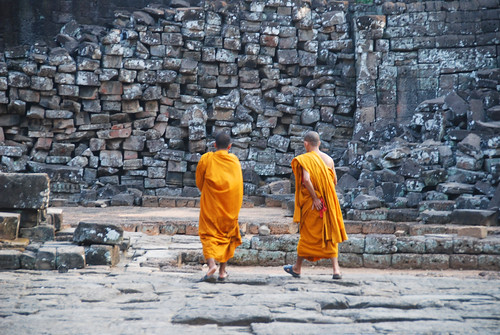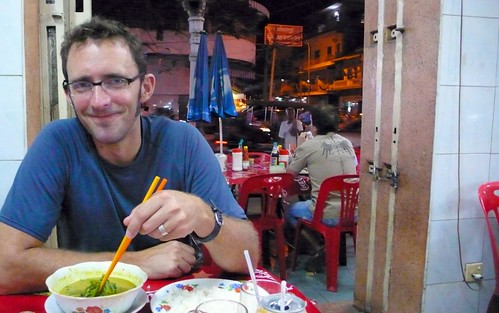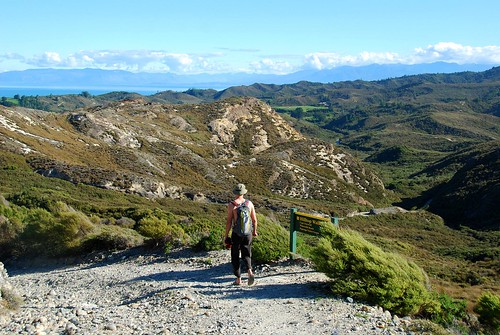Posts Tagged ‘summary’
Note: If you’re wondering why we did not do wrap-ups for Thailand and Malaysia yet, it’s because we are planning on returning to both countries towards the end of our SE Asia tour.
Days spent here: 7 (February 6-12, 2009)
Prices: We’ve heard a lot of backpackers complain that Cambodia was expensive relative to the rest of SE Asia, and we agree, though we didn’t feel it was outrageously so. In Siem Reap, our hotel (Mandalay Inn) was one of the nicest we stayed in, and one of the cheapest. However, food was on the pricey side (US$3-8 for mains) and the pass to visit Temples of Angkor was definitely expensive (US$40 for a 3-day pass), plus it costs an additional US$12 to hire a tuk-tuk driver to take you into the park (for a full day). In Phnom Penh, our accommodation was moderately priced but not that nice (we paid US$14 for a room without a window)…we got less for our money here. Food was on the spendy side as well.
Places we visited: Siem Reap and the Temples of Angkor, Phnom Penh.
Places we would happily visit again: We LOVED the town of Siem Reap, and the temples just speak for themselves. Even beyond the majesty of Angkor Wat, the town itself was really charming and the people were so nice. Phnom Penh, on the other hand, did not share the same charm; it was sort of a generic SE Asian capital city (in our limited experience of it), and there were a lot of Western tourists, which created a limited set of interactions between foreigners and the local people.
Places we want to see next time: Kratie, where you can see river dolphins, and Sihanoukville, the one big Cambodian beach destination.
Food: Khmer food is good! It has the richness of Thai food but the freshness of Vietnamese food. We sort of tired of it by the end of our visit, but we basically ate Khmer dishes for an entire week so I don’t think that reflects badly on the food. The one standout dish was “green soup” (not terribly descriptive, but that’s what the menu called it), which we had at a food stall in Phnom Penh.
Dust: It’s freakin’ dusty in Siem Reap! When you’re in the back of a tuk-tuk on the way to the temples, do as the locals do and tie a checkered Cambodian scarf around your face to keep out the dust and exhaust. You can buy these for about US$1 at the local markets.
Cambodia wins the “most family members on a motorbike award”: It is VERY common to see an entire family of four or five on a motorbike in Cambodia. The typical configuration is this: oldest child (usually a toddler) in between the driver’s (usually Dad’s) legs, second oldest child wedged between Mom and Dad, and a baby in Mom’s arms. These people grow up on motorbikes so they are very comfortable with the arrangement, though it is very shocking to us safety-conscious Americans.
Check out our Cambodia Flickr album
Everything you’ve heard about Australia is true: the beaches are gorgeous, the people are friendly, and Aussies really know how to appreciate their beautiful coast, especially around the holidays. This is a huge, very flat country, and the effect of all that flatness is that it makes the land seem even more vast, since you can see so very far across the landscape without all those pesky mountains blocking your view.
Australia is pretty much the same size as the US (with only 5% the number of people), and we only saw the east side of the country, but still we were impressed by how much the states differed, especially in relation to the coastline. In New South Wales, it was all surfing all the time: pristine waters, big waves, vast beaches, and clear skies. In Melbourne and the Great Ocean Road, it was rocky coastline (sometimes it looked more like New Zealand than Australia), turbulent surf, and cold, cold water. And finally, in Queensland, the beaches were muddy, the sky was overcast (we were there during the stormy season), and the water was filled with deadly creatures (crocs and jellyfish). In fact, sometimes it feels like we visited three different countries, kind of like how it might feel if you visited California, New York, and Florida, for instance.

Beach near the 12 Apostles on the Great Ocean Road.
And finally, it’s true: Aussies really are super friendly, generous, and fun-loving people. We met a lot of new friends here that had no hesitation hanging out for a day or evening with two complete strangers (that’s us), and showing us all the hidden gems in their respective cities. We were so impressed with Aussie hospitality, hopefully that’s something we can bring home with us. ![]()
Days spent here: 38
Average daily expenditures: US$210
Prices: Accommodation was quite expensive in Australia, we typically spent between US$70 and US$125 per night here. Everything else is pretty equivalent to US prices, perhaps a bit cheaper due to a favorable exchange rate. Internet access is not cheap, except in Melbourne.
Weather: Australia is known for its sunny weather, and indeed, it is quite temperate in Sydney (between 80 and 90 degrees F most of the days we were there), growing hotter and wetter the further north you go, and logically, colder the further south you go. We were surprised at how chilly it could get in Melbourne…the weather is also quite unpredictable there (”four seasons in a day”).
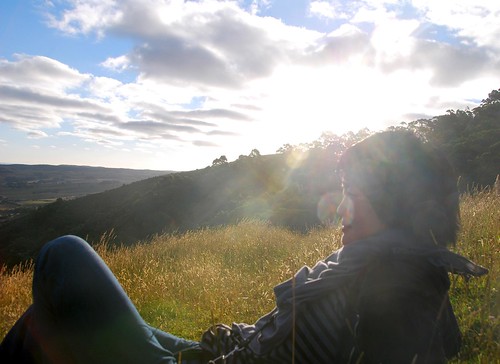
Sunny but cold up on Mariner’s Point in Apollo Bay.
Places we visited: In New South Wales: the coast from Sydney to Byron Bay; in Victoria: Melbourne and the Great Ocean Road up to Apollo Bay; in Queensland: Cairns to Cape Tribulation.
Places we would happily visit again: Melbourne
Highlights: NSW: Valla Beach (the water was SO clear here), Yamba, Crescent Head, Pacific Palms, sailing in Sydney; Victoria: Fitzroy district and the laneway bars in Melbourne; Queensland: the Great Barrier Reef.
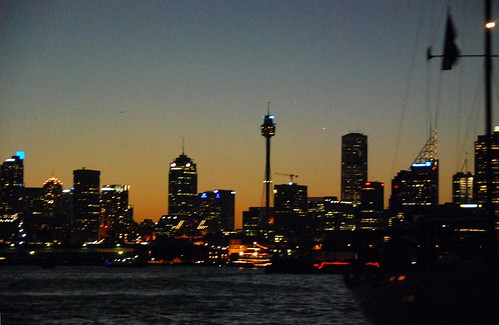
Sailing on New Year’s Eve in the Sydney Harbour.
Places we want to see next time: The west coast of Australia, esp. Perth and south of Perth (we hear it is really beautiful and serene there), Darwin.
Phrases we never heard an Aussie say: “Crikey,” “g’day,” “shrimp on the barbie” (they refer to those delicious crustaceans as prawns…”shrimp” are tiny little things that would fall through a BBQ grate; and Aussies just say “barbeque,” like Americans do).
Phrases Aussies really do say ALL THE TIME: “Mate,” “How ya goin’?” (standard greeting), and “No worries” (the standard response to an apology or expression of thanks).
Our favorite Aussie slang word: “Bogan” (American equivalent of “redneck” or “hick,” kind of affectionate and derogatory at the same time, taught to us by Jackie in Melbourne. We love this word! And yes, we met many bogans on our trip).
Aussies and their sport: Oh my, do Aussies love their cricket. This is a very confusing game to us…it can last up to 5 days, there are all sorts of strange rules, and the point of the game is to knock two little pegs off of 3 vertical sticks. During our stay, we got a general idea of how the game is played, but we were not infected with cricket mania.
Aussies and their booze: Yeah, the rumors are true: Australians really know how to drink. First of all, each state has a beer of choice…in NSW, it’s Victoria Bitter (or VB), Melbournites seem to drink more wine than beer (though their local brewery Bright Creatures makes a mean bright ale), and in Queensland, it’s all XXXX, all the time (nobody but Americans drink Foster’s as far as we can tell). In addition, if you walk into a bar, you can’t just order a pint…there are all different size glasses that go by very undescriptive names like “pony” and “schooner.” Even more confusing, a “pony” in Queensland can be a different size than a “pony” in Victoria.
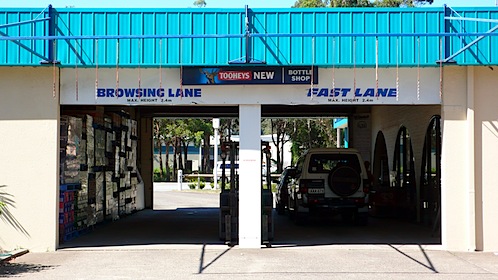
At the bottle shop (liquor store)…you can jump in the “browsing lane” or the “fast lane” if you’re in a big hurry to get your drink on.
We also heard about (but never witnessed) a ritual called “Sunday Sessions.” Basically, people of all ages start drinking at 10AM on a Sunday and don’t stop until they are passed out on the ground (usually in the early evening). Just another way that Aussies enjoy life to its fullest, we suppose.
Aussies and their feet: Wow, Aussies have tough feet. Seriously, everyone walks around barefoot like it’s no big deal. We tried this a few times and ouch! The sand is hot and the rocks are sharp! But really, everyone from little kids to old timers walk around on every surface without trouble. We’ll keep our flip flops on, thankyouverymuch.
Aussies and their giant fiberglass food products: On our drive up the coast of New South Wales, we saw a giant fiberglass banana near Coffs Harbour, and a giant prawn (REALLY giant) on the roof of a restaurant…somewhere else (we forget where it was). We’ve also seen photos of a giant pineapple in Noosa Head. There’s even an billboard featuring all the different giant food items. I don’t think we’ve ever been to another country where there were so many giant fiberglass foods.
Aussie sense of humor: OK, maybe it’s unfair to generalize and say that ALL Aussies have a weird sense of humor, but we saw enough evidence of it that we feel confident saying that many Aussies do. For instance, there is a commercial on Australian TV that has a beaver selling tampons. No joke. A girl walks around the city with her pet beaver, and the idea is “you wouldn’t treat your best mate badly, so why use another brand of tampons?”
Also, even though our Hippie van looked silly, at least we didn’t have a Wicked van…all of their vans are spray-painted differently and have phrases like “if it weren’t for money, women wouldn’t be interested in men at all” or “mobile breast exam” scrawled across the back. Can you imagine us tooling around Australia in a van like that? Or, you could get stuck with the “Dirty Sanchez” van (these also come in “Donkey Punch” and “Pirate Booty” versions):
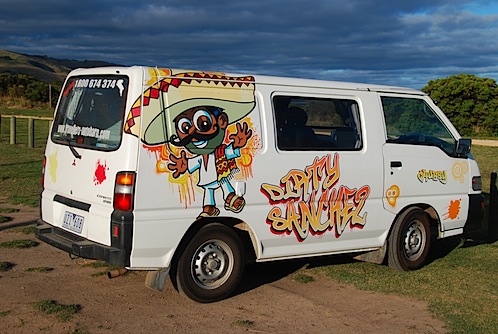
Internet: Australia has a telecom monopoly going on (Telstra), and the result is that internet access is expensive and slow. We were quite surprised by this…we thought a first-world country like Australia would surely have fast, cheap access for its residents in order to keep it competitive in the world. Unfortunately, this is not the case…we have had better access in New Zealand and Asia. The friends we met/visited here tell us tales of confusing Internet plans that allow a certain amount of traffic a month and then once that allotment is met, access is either cut off for the month or it becomes excruciatingly slow. The one exception is Melbourne, where wi-fi was readily available for cheap or free.
Food: Overall, the food in Australia was good, but not amazing. We mostly cooked for ourselves the 2 weeks that we were in a camper and for the week that we had an apartment in Sydney. The meat and produce was all fresh and good, although selection was at times limited. We ate out a few times in Sydney and had one exceptional meal at an Indian restaurant, some of the best Indian food either of us has had. We hear that there are some fantastic restaurants in Sydney, but unfortunately, we had to skip for budget reasons. I guess that means we will have to come back.
Kangaroo meat is the big eco food in Australia, kind of like bamboo for flooring in the US. Kangaroos are plainly abundant in many parts and the meat is very lean. We have to admit, we were too squeamish at the time to try any. Some Aussies we spoke with refused to eat it. Others said “its not that bad”. Probably tastes a bit like venison.

Kangaroo meat for sale at the supermarket.
Surf: The surf in Australia is, not surprisingly, amazing. On the East, South, and West coasts, there are endless beaches, points, and reefs with great waves. As long as there is a swell in the water, there will be a spot nearby that works with the current wind and tide. It is no wonder that Oz holds the spot that it does in surf lore.
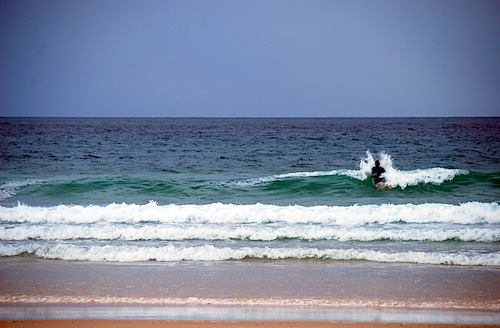
Jeremy heading out for a session off Angourie Point.
The downside is that with great waves come lots of surfers—and in this case, lots of amazing surfers. Everyone seems to surf, and they all rip. The average surfer at a break in Australia would probably be one of the better surfers at a comparable break in the US. It’s fun to watch, but it is a little intimidating out in the water. Fortunately, the breaks that we visited had plenty of waves for all, so the vibe in the water was not at all negative.
There are definitely sharks in Australia and the guidebooks all make references to sightings and attacks. But, as is the case in shark infested Northern California you are pretty unlikely to have a problem. Car accidents and apparently falling coconuts are a much more real danger. But I was happy that an unusual and highly publicized string of 3 or 4 attacks in NSW in late 2008 happened right after I sent my surfboard home.
In Short: We’re glad we finally got a chance to visit this big island down under. If it’s a beach vacation you’re after (perhaps interspersed with some visits to a few world-class cities), Oz is your place! But for us, we enjoyed the people we met here more than the landscape—don’t get us wrong, we LOVED the swimming in the ocean and seeing life in Sydney and Melbourne—but it’s all beaches, all the time, and it seems the personalities we encountered varied more than the landscape did.
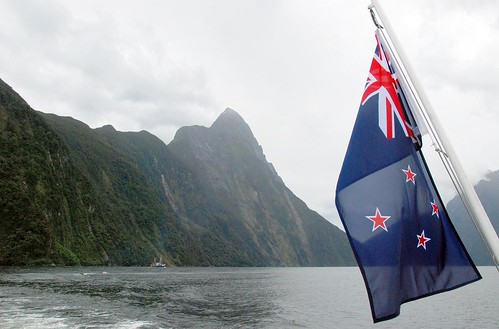
The NZ flag on the back of our Milford Sound cruise boat.
New Zealand is, quite simply, magical. For any person who appreciates nature or the bounties of this planet, NZ is where it’s at! We’ve never been to any place that has been so consistently beautiful. There are only 4 million people on this island (3 million on the north island and 1 million on the south), so you will often have entire beaches, holiday parks, or hiking trails all to yourself.
Traveling in a camper van is the way we did it, and definitely the way we would do it again…though it may be just as nice (and cheaper) traveling in a rental car with a tent (you’ll have to cross your fingers for good weather). Driving long distances in NZ is not hard, because the scenery is so beautiful and the sights so different and engaging around each bend that you stay interested throughout the drive.
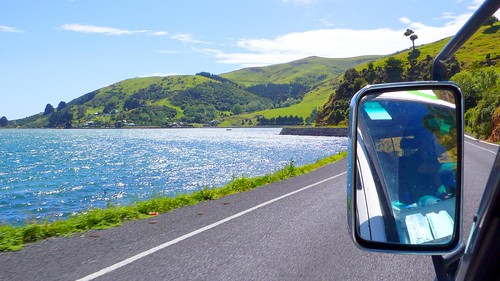
A typically beautiful NZ drive: on the Otago Peninsula.
Traveling here is incredibly easy. The staff at local i-Sites (NZ tourist information centers) are super nice and helpful. Road signage is quite good and we recommend you pick up a New Zealand Traveler’s Road Atlas by kiwimaps (costs around NZ$25) at a local supermarket or i-Site. Even if your car comes with a touring map or you have a guide book, it’s worth it. They are super easy to use and labeled with icons that tell you what the local activities are (ex. fishing, surfing, etc.) and what towns have holiday parks where you can camp.
We don’t have the same bias towards the south island that a lot of our friends have…we truly love them both equally. If we had to do it over again, we would stay here an extra week or two so we could spend a bit more time in some places.
Days spent here: 28
Number of Kilometers Traveled: 5000+
Average Daily Expenditures: US$140 (sorry, did some bad accounting…the total was actually:) US$120; the van was approx. USD$43 per day, so additional expenses were on holiday park fees, gas, internet access, food, ferries, clothing, etc. (Note: towards the beginning of the trip, we were not as careful and were averaging $170/day. We made a few changes and significantly reduced our daily average, see below for details.)
Prices: A bit cheaper overall than US prices, though not as cheap as you might hope.
Weather: It can get quite cold in NZ, and very windy (Hope was quite happy she brought her lightweight down jacket). Weather tends to be pretty extreme: either full sun and blue skies or cloud cover with rain. It’s best to prepare for all conditions.

Beautiful, sunny Pohara Beach.

Cold and rainy near the Rob Roy glacier.
North Island Highlights: Driving around Mt. Tanaki/Egmont (SH45—the “surf highway”), east coast of Coromandel Peninsula, Wellington
South Island Highlights: Nelson (esp. Whariki Beach), Wanaka, Milford Sound, Otago Peninsula
Places we wish we could have visited: Stewart Island, Mount Cook, Bay of Islands
What we would do the same: Travel in a camper van.
What we will do differently next time: Stay a week or two or ten longer; skip the west coast of the south island (which is a sand fly convention) and explore the middle of the island more; charter a boat and explore Fiordland; see the areas north of Auckland; multi-day hut-to-hut hikes near Wanaka and Milford; watch the extended version of the Lord of the Rings trilogy while traveling around NZ.
How we kept the costs down:
- We cooked A LOT…we only ate out 11 times in the 28 days (x 3 meals) we were here. Partly this is because the food here is so similar to food in Northern CA, so we didn’t feel like we were missing out by cooking so much.
- Freedom camped every other night instead of staying in holiday parks.
- Avoided touristy experiences: For example, we decided not to pay the NZ$31 to go into Orakei Korako.
- Ate less meat: even though it is cheaper here, it is still a large portion of the grocery costs, so we started using it more as a flavoring and less as a main part of the dish.
- Took advantage of free wi-fi in the libraries of major cities.
- Used our fuel vouchers (see below).
Internet: Surprisingly, not a great internet situation here. Virtually every holiday park has wireless access, so it is widely available, but it can be expensive—up to NZ$10 per hour. Maybe this isn’t outrageous, but we were expecting it to be cheaper. Also, internet access can often be limited not just by time, but by the amount of data transfered (ex. 50 MB max). A few times, we purchased 2 hour access, only to reach our data limit within 30 minutes. According to a tech guy we corresponded with, this is because NZ is one of the only first-world countries that still has data restrictions. (Note: After traveling Australia, where internet access at holiday parks is not a given, we are amending our opinion of NZ’s internet situation in a positive direction).
Favorite Grocery Store: New World—They have the best and highest quality selection, by far.
Least Favorite Grocery Store: Fresh Choice—we found a worm wriggling out of a slice of ham we bought from the deli counter there. ‘Nuff said.
Food: Super fresh meat and veggies. Obviously, lamb is extremely top-quality here, but so is beef and pork. Jeremy has some beef (ha ha) with the way meat is butchered here, however. Often a pork chop or cut of steak will include a lot of fat and the “rind” (the skin). A little creepy for us Americans.
The grocery store sells about 17 million different varieties of bacon. Animal products like cheese and eggs are also amazing. Most grocery stores do not sell beyond lamb, beef, chicken, and pork (i.e., no turkey).
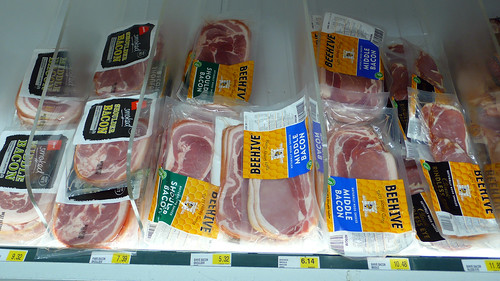
The bacon selection in a tiny little grocery store…this was probably equal to their entire produce section. ![]()
Veggies here are also super fresh and for some reason, asparagus was super cheap while we were here. However, garlic was often really bad (wilting and sprouting). The best part of grocery shopping in NZ is that there are often little farms along the road and you can just pull over and buy ultra fresh veggies, fruit, or eggs from the residents.
Holiday Parks: Holiday parks are large campgrounds that offer powered sites (for camper vans like ours that can plug in) and non-powered sites (for tents), hostel-like accommodations, or “self-contained” units (rooms with kitchen and bath included). Obviously, we only used the power sites in holiday parks so we can’t vouch for the self-contained or bunk units. All power sites come with power hookup and a water spout, as well as access to communal kitchens (the nicer holiday parks have soap, sponges, pots, pans, etc…others don’t, but our van came with all of that), bathroom and showers (sometimes you have to pay for the showers, sometimes you don’t), and access to other amenities like a TV room (free), playgrounds and trampolines for the kids, laundry (prices differ), or, in the case of the last holiday park we stayed in, a hot mineral pool. To stay at a power site in a holiday park generally costs between NZ$24 and $36 per night. The fancier parks near the big cities are more expensive and have nicer amenities, but we tend to like the ones out in the middle of nowhere since they are quieter and usually family-run. It seems like all holiday parks in NZ have wireless internet access (cheaper in the big cities).
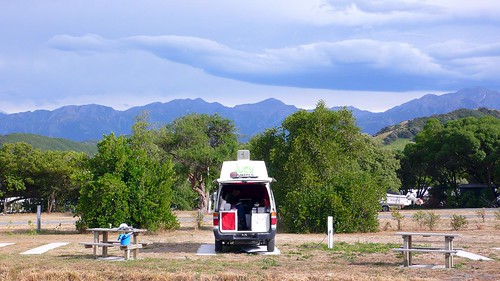
Cool clouds behind the holiday park in Peketa.
Most holiday parks are located on incredibly beautiful plots of land with sensational views. Some holiday parks seem to allow long-term residents, so it is a cheap way for Kiwis to have a vacation home in a prime location.
Gas/Petrol: While we were in NZ, the price fluctuated between NZ$1.16 and NZ$1.23 per liter for diesel (approx. US$2.71 per gallon). It seems that gas prices are kept at a pretty consistent rate from station to station (unlike in the US where the prices can vary from block to block). The one exception is in hard-to-get-to places, like a town at the end of a peninsula or something similar (where gas can be more expensive).
Also, important note: if you spend more than a certain amount (I think it is NZ$25) at some of the bigger grocery stores, you will get a coupon for 4 cents off every liter of fuel you purchase. For example, New World gives you a discount at BP; Woolworth’s gives you a discount at Shell, etc. Be sure to keep these coupons! The savings really add up.
Surf: The surf was a little disappointing for us (or for Jeremy anyway). There are so many deserted beaches, rocky points, and river mouths which must product amazing waves with the right swell and tide. But we were there in the spring which, it seems, has less consistent swell than other times of the year. The swells that did come through tended to only produce waves for a few hours or half a day. On the flip side, no waves meant that we were free to explore everything else that New Zealand had to offer, which is plenty.
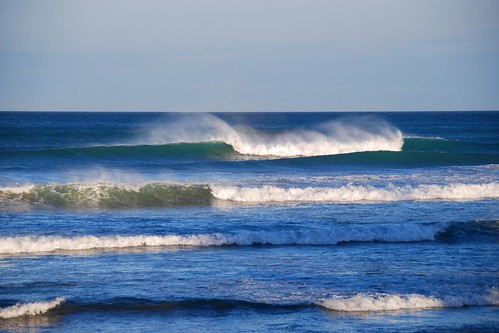
Nice-looking “rooster tails” at Waihi Beach.
We did meet up with a good swell our last few days in New Zealand in the Coromandel region of the North Island. There were fun waves at an empty beach break (Jeremy was the only one in the water) at Waihi. And there were exceptional waves (overhead, endless lefts; 10 waves per set) at a very crowded point break at Whangamata. Other areas that looked promising for a future trip: Raglan (of course), “The Surf Highway” to the south of New Plymouth, the Otago Peninsula (near Dunedin) and the Banks Peninsula (near Christchurch).
The water is cold on the South Island; Jeremy brought his 4/3 wetsuit, booties and hood and would have needed them all if he got in the water. It is quite a bit warmer around the North Island; Jeremy surfed a few times in shorts and a neoprene rash guard (not quite warm enough) and a few times in his wetsuit (way too warm). A shorty would have been better.
Hiking: The hiking in New Zealand is superb. There are endless beaches, rolling pasture land, sub-tropical rain forests, mountains and glaciers to explore. The i-Sites typically have good regional maps and recommendations for hikes of varying length and difficulty. As we have mentioned a few times already, we were surprised again and again at how accurate the estimated hiking times are. Each time we (or Jeremy) would say “there is no way that hike is going to take us 5-6 hours!” But sure enough, even at a strenuous pace and few rest stops, that hike would take us 5.5 hours.
In addition to day hikes, New Zealand has an extensive network on wilderness huts that you can reserve for multi-day trips. The ones we saw were basic but they are plenty to protect you from a storm or cold weather and let you leave the tent behind. We will definitely need to take advantage of these next time.
In Short: We LOVE New Zealand! We have a hard time even thinking of one spot that was not incredibly beautiful. NZ is definitely a country we will return to for an extended trip or maybe to live? ![]()
